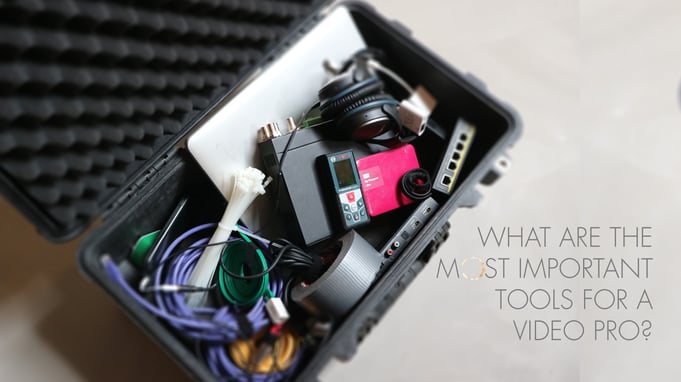
As any craftsman will tell you, it’s not only a matter of knowing what you’re doing, but also having the right tools for the job. And in the case of video professionals, there are an awful lot of tools out there. Here's a list of my essential items. Think I’ve missed something off the list? Add your favorite in the comments box below!
- Carry-on or check-in?
- The importance of saying no
- And now to the tools
- Don't forget…
A Facebook group of video professionals was recently asked the question “which are your preferred tools?” Ever since, I’ve been making a mental list of what I would pack before going on a job. Here’s what’s in my techie carryall:
Carry on or check-in?
Actually, hold that thought, because first of all you need to make a more overarching decision regarding the size and weight of your luggage. Do you want to carry-on or do you want to check it? My personal view is that I do carry-on if I can, and if I need to check something… I still carry quite a few things on board. Things I really, really cannot live without – just in case, you know, the airline manages to lose track of your luggage…
The importance of saying no
If you have ever done ANY live event in the corporate world, you know that there will be last-minute changes. A wrong text or background, a logo that was updated six years ago or grabbed from the Internet, the presenter’s picture that turns out to be a random dude you found Googling, or the classic question-slash-command, usually uttered just before the presenter walks on stage: “Can you add these three slides to my presentation, after 9, 13 and 17 and add the two videos to my presentation on slides 4 and 6?”
No, kind sir/madam, I cannot do that unless you want to possibly ruin everything. In other words, learn how to say NO.
The ability to say 'No' to is crucial for your own well-being. Being able to deliver a look that curdles milk when asked to do the impossible is one way. Another method is to firmly, but politely, say to A that it is not possible unless A wants to risk something bigger, perhaps even the entire show.
AND NOW TO THE tools
So, let's have a look at what came up during the discussion on Facebook and made it on to my list, too!
PORTABLE SSD DRIVES, EXFAT FORMAT
Preferably USB 3.0 or USB C – with appropriate converters. Having the disk in ExFat format ensures it can be read by both Mac and PC. The FAT32 can also be read by both, but it has a file limit of 4GB so that does not cut it for a media of larger sizes….;
SIGNAL CONVERTERS
Regardless of the job, it’s essential to have a device that can convert a signal plus supports scaling and frame rate conversion. You never know what kind of signals you’ll get, but you should know, more or less, what you want.
Products like HDMI/SDI cross converters which also handle scaling and conversion are recommended. One single signal converter might not do the trick and depending on how often you are exposed to DisplayPort or DVI, you should, of course, also consider adding more converters to your box. Not all converters need to do scaling and frame-rate conversion – they could be more passive converters. Just make sure you have enough.
PATTERN GENERATOR, SIGNAL ANALYZER
In addition to a signal converter, you should have a pattern generator in your toolbox. If you can afford it, opt for a more expensive one with a decent signal analyzer and an EDID analysis tool as well. There are even combined converter and pattern generators. That reduces the number of components and is perhaps a good way to go.
EDID problems have brought both bold and skilled AV crews to tears. Make sure it does not happen to you.
TEST MONITOR
Having a small, compact and rugged test monitor available can prove very useful. Maybe you’ll need a second screen for some reason, or just simply to be able to test if you have a signal all the way down the signal path. Some of these small compact screens even have a recording function which might come handy.
LASER DISTANCE FINDER
If you need to find the distance from any point to any object. Bring a laser finder.
AUDIO TESTER DEVICE
Need to troubleshoot your audio part of the setup? Having an audio tester lets you both generate and analyze the audio signals. It would ideally have a microphone, speaker, test tone generator, outputs for headphones and speakers and a jack for line-in.
EAR PLUGS, PROTECTORS, HEADPHONES, NOISE CANCELLING HEADPHONES
First and most importantly, you need to take care of your ears. Second, you might want to be able to listen to music while concentrating on the job with reduced noise from the outside. If you are not too fussed about the listening-to-music-experience, a set of head phones without noise cancelling will do it.
A KILLER PRODUCTION LAPTOP
…with all the goodies on it. Depending on needs, a heavy-duty Mac set up to run Windows, too, can be ideal – or if you need to have two systems, both a Mac and a Windows based PC? Although it depends on what you personally are capable of doing creatively, having a tool that allows you to edit, render and create content for a client on-the-fly is a must. A laptop equipped with Adobe’s design suite and your creative tools of choice can help save the day.
BLACKWRAP OR CINEFOIL
It has never hurt anyone involved in live events, professional touring or even in fixed installs to carry a couple of sheets of heavy-duty black aluminium foil. Use it to mask unwanted light leaks or reflections, or – as with the thinner, shiny household stuff – wrap what you did not manage to eat when you were disturbed during your designated lunch break. No lunch break, you said? Well, go grab your cold and dry Philly cheese steak then, if you did not wrap it. ;)
GAFFER OR DUCT TAPE
Does this item even need an explanation? Like the old adage says – if something does not work, you’ve just not used enough gaffer/duct tape… You might not need both, but you need at least one of them. Gaffer does not leave the same residue as duct does, but the duct with its sticky adhesive is better for slightly more permanent and heavy-duty materials. The duct is also waterproof so you can fix leaks – if you are hired for an outdoor gig with chances for rain? Bring your duct!
NETWORK CABLE EXTENDERS & COUPLERS
Pack a classic RJ45 extender plug, or even better, pack 10 of them. Make sure they are for the highest quality CAT cables. With more and more equipment on ethernet these days, being able to extend the cables is crucial.
ADAPTERS
You just never know so be prepared… carry adapters for DisplayPort to HDMI, DVI. USB-C to DisplayPort, HDMI.
NETWORK SPLITTER/SWITCH/ROUTER/WIFI
A small five-port switch can be OK, preferably with 10Gb but at least 1GB ports. Autoswitch is a requirement!
HDCP TOOL
I am most likely not allowed to say this, but there are cheap, affordable boxes out there that can help on the many challenges you can encounter with a full HDCP workflow. Note that my advice here is not intended to be a law-breaker to help people avoid copyright protection, but to make sure you have a picture on the wall – compared to the dreaded black if a HDCP issue occurs. The best and legal way is of course to have a converter from a HDCP-based source, such as HDMI to SDI, and let the rest be SDI components, but sometimes you need a device that basically “strips” the HDCP from the signal. These boxes range from 15 USD at DealExtreme to 100+ USD. I always carried two or three of the 15 dollar boxes. Worked like a charm.
CABLES
Having a select set of cables handy has never hurt anyone. Cables can take quite a bit of space, so perhaps consider limiting it to a couple of network cables and a high-end video cable (with a set of converters to support it). If you bring a HDMI cable, you have, of course, HDMI->everything and everything->HDMI converters!
CABLE TIES
Gaffer or duct is one thing, but on any live event, fixed install or whatever, just having a few cable ties can make a difference. They are small, light and cheap – there is just no excuse not to have a handful of them, maybe even in two or three sizes. It’s up to you if you prefer zip ties or the Velcro reusable ones. In my toolbox I have some of both.
VELCRO
Who knows when you’ll need to stick things together. A Velcro hook and loop fastener beats a duct-tape loop hands-down.
Don't forget…
Coffee. Don´t leave home without it! I am a coffee junkie and without steady supplies, I go nuts. At gigs without confirmed access to coffee, you’d find me clutching my own thermos.
In addition to the above-mentioned AV-related tools, you obviously need a set of pliers, screwdrivers, cutters, ….
What do you think? Are there any tools missing – and why?
READ PART TWO!
Don't miss the follow-up to this post based on comments from media server pros!
Follow-up: What are the most important tools for a video professional?





